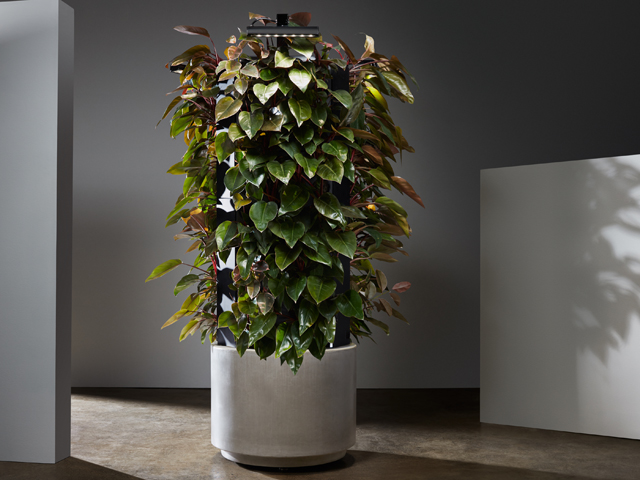Breathing Wall

Junglefy Breathing Wall By Adam Cornish
Australian green wall and living infrastructure specialists Junglefy and designer Adam Cornish have collaborated to produce a unique plant-based filter system 'Breathing Wall' which, actively cleans polluted air.
How Does It Work?
The Junglefy Breathing Wall is an active, modular green wall system, scientifically proven to accelerate the removal of air pollutants, such as carbon dioxide, particulates and volatile organic compounds faster than any other plant-based system on the market. It also acts as a sound barrier, improving acoustics while cooling the surrounding air temperature, resulting in energy efficiency and reduced air conditioning costs.
The Junglefy Breathing Wall is made up of modules composed of linear, polypropylene with infinite recyclability, supplied with a growing medium high in coconut fibre. The system is ventilated via an electric axial impeller, providing a uniform airflow across plants and growing medium. This active ventilation increases the rate of carbon dioxide draw down, and the volume of air that can be filtered and cooled by each module. The Junglefy Breathing Wall isn't just attractive. It actively cleans the air to provide a safer, more comfortable and productive working and living environment.
"The Breathing Wall system was designed with the simple aim of harnessing nature's inherent air cleaning and purifying qualities. Through scientific research we were able to focus in on the exact biological mechanisms that filter the air and through design, enhance these features to give greater filtration than what occurs naturally," describes designer Adam Cornish.
Key Benefits and Features?
The seemingly simple design has a series of benefits aimed to encourage and increase what mother nature does best:
• Unlike traditional potted plants and green walls, the Breathing Wall system utilises the plant, root bundle and growing medium to filter the air. Utilising the root bundle and growing medium greatly increases the amount of air that can be purified per hour, as well as enabling the system to store the pollutants to be later consumed by the plant. The pollutants essentially become stored food for the plant life.
• We have created a unique insulated chamber within the design to house the plants and compostable growing medium. This chamber incorporates tiny fins to better regulate air and moisture levels throughout. These small hidden features create a microclimate suited to the growth of microorganisms responsible for the accelerated purification qualities.
• The Breathing Wall has also been designed to move the air through the module in an even, regulated manner. This process has been achieved through a patented air spreading plenum device. The plenum creates even air pressure across all plant life and root bundles, spreading the air and allowing each plant to better absorb the airborne pollutants.
• In keeping with the sustainable nature of the product the material selection contains 25% calcium carbonate (sediment created from limestone) and 75% polypropylene. This material was chosen for its 100% recyclability and 25% reduction in virgin material, plus its ability to stand up to the harsh conditions associated with horticultural growing environments.
• The Breathing Wall module has been designed as part of a modular system. The system-based approach allows the product to be used in small or large numbers from compact internal walls in homes and offices, to larger living infrastructure projects including motorway tunnel filtration and entire building facades. The module has been designed for disassembly with each component able to be replaced and maintained as well as separated into individual waste streams for recycling at the end of the product lifecycle.
• In order to make this design agile and suitable for the modern office, mobile 'Breathing Totems' have been designed to incorporate the module technology. Using the same module, the Totem incorporates the living filters into portable green columns. Available with locking castors, the user can place the units where they are most needed, creating flexibility and agility in line with contemporary office design.
What Are The Research Findings?
According to the five-year study carried out by the Plants and Environmental Quality Research Group at UTS, research findings on the Junglefy Breathing Wall indicate: *
1. Carbon Dioxide Reduction Carbon dioxide (CO2 ) is exhaled as the result of human respiration. High concentrations in our indoor environments can lead to headaches, lethargy and poor productivity as well as increased demand on mechanical air conditioning systems to clean the air. Plants reduce CO2 through photosynthesis and create oxygen. The Junglefy Breathing Wall can remove 24.2 litres of CO2 per hour. This is the highest recorded CO2 removal rate recorded in scientific literature. A 10m2 Breathing Wall could balance out the respiratory emissions of 4-5 building occupants based on an occupying time of normal business hours.
2. Volatile Organic Compounds Removal Volatile organic compounds (VOCs) are toxic gases released from deodorants, perfumes, plastics, carpets, furnishings, paints, and cleaning products. VOCs are captured in the growing medium of the Junglefy Breathing Wall, where they are broken down and absorbed for biological processes. The Junglefy Breathing Wall removes VOCs 1.5 times faster than equivalent volume of pot plants. This means that a Junglefy Breathing Wall will remove VOCs at the same rate as 160 large pot plants.
3. Particulate Matter Filtration Particulate matter (PM) includes emissions from vehicle exhausts, and is one of the world's worst air pollutants, leading to more 600,000 deaths per year in China alone. Particles less than or equal to 2.5 microns in diameter are so small that they can get into the lungs, potentially causing serious health problems. Two point five microns is less than the width of a single human hair. The Junglefy Breathing Wall filters
4. Noise Reduction Due to our love of open plan spaces, many indoor environments can be very noisy, which can be highly distracting and lead to poor productivity. The Junglefy Breathing Wall reduces reflected noise by 41% compared to a conventional building wall.
5. Biophilic Response Indoor plants are well known to reduce stress, sick leave and poor productivity. This effect is known as 'biophilia'. Many sustainable building rating tools have recognised the value of biophilia and have therefore included human access to nature within their recommendations. The Junglefy Breathing Wall is an effective space saving means of introducing nature into our internal built environments, creating healthier and happier building occupants.
6. Energy Efficiency And Impact On Heating Ventilation And Air Conditioning Systems Heating Ventilation and Air Conditioning (HVAC) systems are highly energy intensive. In fact, 48–56% of an average building's energy consumption is attributed to a building's HVAC system.1 The Junglefy Breathing Wall reduces a building's reliance on HVAC systems in three important ways. It actively reduces CO2 levels and filters out other pollutants, it cools ambient temperatures, and it humidifies the air. Simulation room trials demonstrated that a Junglefy Breathing Wall could reduce HVAC energy consumption by 33% for an average sized office, minimising a building's carbon footprint and saving electricity costs.
* Estimates based on a 10m2 Breathing Wall in a 100m2 office with 2.6m ceiling with 10 occupants with 1 fan under 100μE of light.
Junglefy Breathing Wall At Denfair 2019
The Clean Air installation will be on display at The Concourse at Denfair, Melbourne Convention and Exhibition Centre.
For more information about the Junglefy Breathing Wall or living infrastructure, visit junglefy.com.au To connect or view more designs by Adam Cornish Design, visit adamcornish.com
Images credit: Willem-Dirk du Toit
MORE



